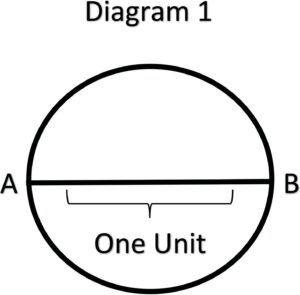14 Origin of Pi
A wood worker must have a good understanding of geometry to produce curved surfaces. Some base their whole building on mathematical forms. Circular patios, tables, doors… it is very useful to understand working with pi when building. Pi, symbolised by π, has always been attributed to the ancient Greeks and approximated by the ratio of the circumference of a circle to its diameter which is consistently the same number π. In fact, it was Archimedes who gave it its first approximation by using polygons within the circle and outside the circle. In diagram 1, we take the measure of AB to be 1 unit and thus the circumference is π.

In diagram 2, we can approximate the circumference from the outside of the circle by drawing the square CDFE. Since each side measures 1 unit, then the circumference is at most 4 units.
By Archimedes, we can draw regular polygons inside with fixed lengths to approximate the circumference. Archimedes used a 96-sided polygon from within to give and approximation of 223/71 < p < 22/7 or 3.1408 < p < 3.1429.
Later refinements and calculations gave us the decimal approximation which we have come to know today as p » 3.14159265.


